In America it was called “The Gilded Age” and the “Gay Nineties”. In Britain it was the peak of the Victorian and Edwardian Age. In France, it was called La Belle Époque . . . The Beautiful Era.
For a few brief decades immediately before and after the turn of the 20th Century, Europe and America experienced a period of industrial and technological innovation, and a flowering of artistic creativity that set the stage for the next 100 years. It was the age of the first skyscrapers in Chicago and the construction of the Eiffel Tower; the opening of the world’s first subway systems in London and Paris; the heyday of the Post-Impressionists like Gauguin, Cézanne and Matisse, and the early years of Picasso. British readers were discovering the detective exploits of Sherlock Holmes and French theater-goers were enthralled by the immortal Sarah Bernhardt. The high point of the era was the Paris Universal Exposition of 1900. Remnants of that exposition still remain today and we know them as the Métro, the Grand and Petit Palais, the Musée D’Orsay and the Gare de Lyon.
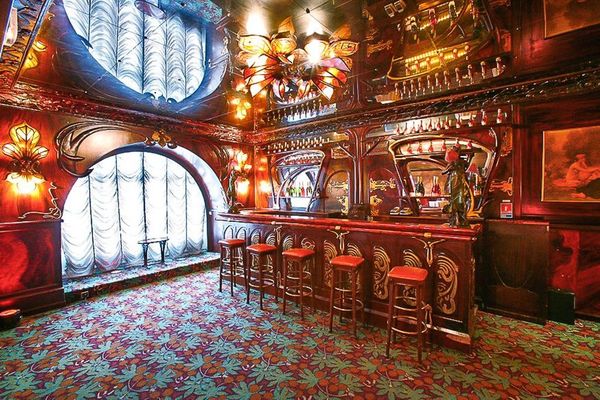
During this era a school of art and architecture was born and rose to prominence; its name: Art Nouveau. Its long sinuous lines and organic elements were a reaction to the rectilinear uniformity of the Haussmann architecture in vogue up till then. It’s curving floral patterns also lent themselves to furniture, jewelry, ceramic tiles and glass, as well as posters and illustrations. This “New Art”, though born in Paris, was a sensation on both sides of the Atlantic. From Paris to Prague and Boston to Barcelona, Art Nouveau was the rage.
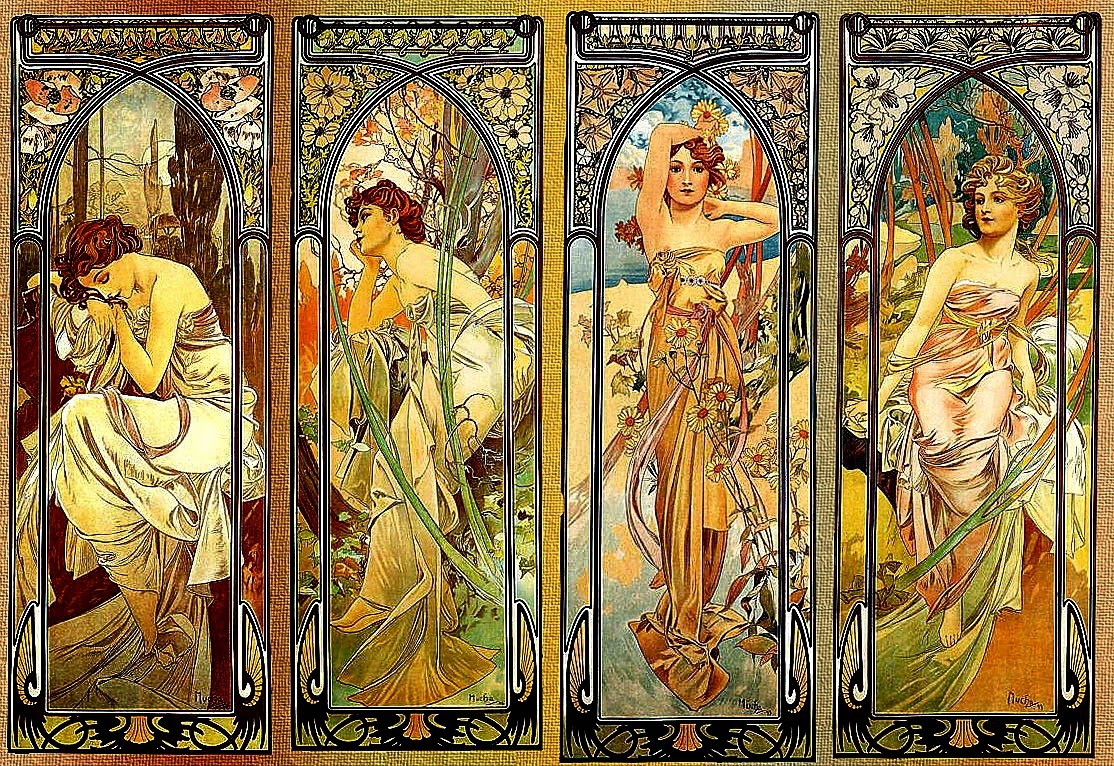
The outbreak of WWI drew the curtain on Art Nouveau, to be replaced after the war by Art Deco. It too would have its heyday for a few decades until the conflagration of WWII brought its popularity to an end as well.
TODAY, a century after Art Nouveau’s demise, there still exist dozens of Parisian brasseries, bistros and cafés that are veritable museum pieces of the Art Nouveau style. The following are six of particular interest. Dining at one of these spots is indeed like stepping back into La Belle Époque
Vagenende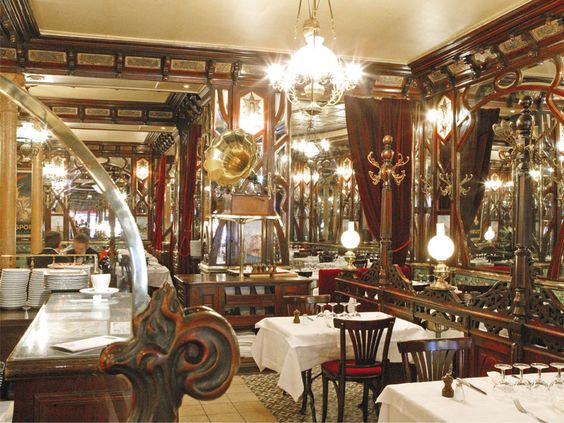
In the heart of the St-Germain-des-Près quarter, a few blocks east of the iconic triad of Les Deux Magots, Café de Flore and Brasserie Lipp, stands a lesser known Fourth Musketeer of Belle Époque eateries; Vagenende.
The restaurant was opened in 1904 by the Chartier Brothers (More about them a little later). It was done in the grand Art Nouveau style made wildly popular at the Paris Universal Exposition of 1900, complete with the Nouille (Noodle) style of curving woodwork surrounding beveled mirrors and painted glass. In 1926 it was taken over by the Vagenende family from whence it takes its present name. By the 1960’s the years were taking their toll on the interior and rising real estate values almost caused the demolition of the restaurant, to be replaced by a super market. It was the intervention of André Malraux, Charles De Gaulle’s Minister of Culture, who saved the place by getting it listed on the Registry of Historical Monuments.
The Egurreguy family took over in 1977 and Monique Egurreguy ran it for many years. In 2010, her daughter Marie took cammand, vowing to update the restaurant while preserving its legacy; a vow she has fulfilled quite nicely. Her young chef, Benoît Vanheesbeke, reinterprets classic brasserie fare with an elegant, creative touch. Today it is a pleasing blend of fin-de-siecle decor and understated cosmopolitan atmosphere.
While the Holy Trinity of Deux Magots, Flore and Lipp still retain their cachet, those who wander down the street to sample Vagenende will certainly find it worthy of inclusion with the other three and actually superior to them in the quality of its cuisine.
Vagenende – 142 Boulevard Saint-Germain, 75006, Tel: 33 1 43 26 68 18
Bouillon Racine
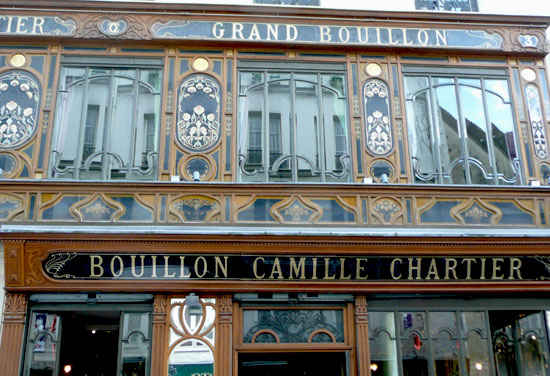
In addition to Vagenende, the Chartier Brothers, Edouard and Camille, opened several other “Bouillon” restaurants at this time. A bouillon (French for broth) was a soup kitchen of sorts, with roots going back to 1850’s Paris and an entrepreneurial butcher named Pierre-Louis Duval. He envisioned a place where workers of meager means could find a hearty meal of vegetable broth and a slab of meat for a modest price. By the turn of the century there were over 200 bouillons across Paris. Following the Universal Exposition of 1900 certain bouillons morphed from modest dining halls into opulent Art Nouveau eateries. The Bouillon on rue Racine was among the finest.
Following its sale by the Chartiers in 1926, it went through a series of owners until it was sold to the staff of the nearby Sorbonne university in 1962. The fathers of the Sorbonne exploited it as a utilitarian faculty dining hall and were not particularly sensitive to its Art Nouveau treasures. Over the next 30 years its decor fell into decay and was in many places covered over with plaster board and formica.
In 1993 a pair of Belgian restaurateurs purchased the property with plans of their own. But when the drywall and formica were removed this Art Nouveau treasure that had lain neglected and largely forgotten once again saw the light of day. Their original design plans were scrapped and, 3 years and $2 million dollars later, the marvelous boiserie, beveled mirrors and custom tiles were as they had been at the Bouillon’s opening in 1906. The building is now on the list of historical monuments.
The restoration required craftsmen with rare and nearly forgotten skills; mosaic tile setters, artisans in beveled mirrors and painted glass, restorers of boiserie and wood. The room’s signature celadon green, rarely seen today, is true to the era.
The current owners of Bouillon Racine also manage the Belle Époque Pharamond Restaurant in the Les Halles neighborhood. Both places offer excellent service and tasty, modern renditions of classic French cuisine.
A legacy of the 1990’s Belgian owners is the restaurant’s extensive selection of Belgian Trappist ales. I frequently drop in for a Belgian ale and a light meal at the bar.
Bouillon Racine –3 rue Racine, 75006 , Tel.: +33 1 44 32 15 60
www.bouillonracine.com/en/welcome/
http://www.idealgourmet.fr/53-restaurant-bouillon-racine-decouverte-presentation-gb.html
Fermette Marbeuf
The story of Fermette Marbeuf’s creation, entombment and resurrection is even more dramatic than that of Bouillon Racine.
Originally built in 1889 as the dining room of the Langham Hotel in the upscale George V neighborhoood, the Salle Verriere (Skylight Room) was in vogue for many years. However, changing tastes finally led to the room being covered in plasterboard, relegated to other uses and quite literally forgotten. It was not until 1978, while renovations were under way, that this Art Nouveau gem was rediscovered. Sadly, the years had not been kind and the original elements were in a sad state.
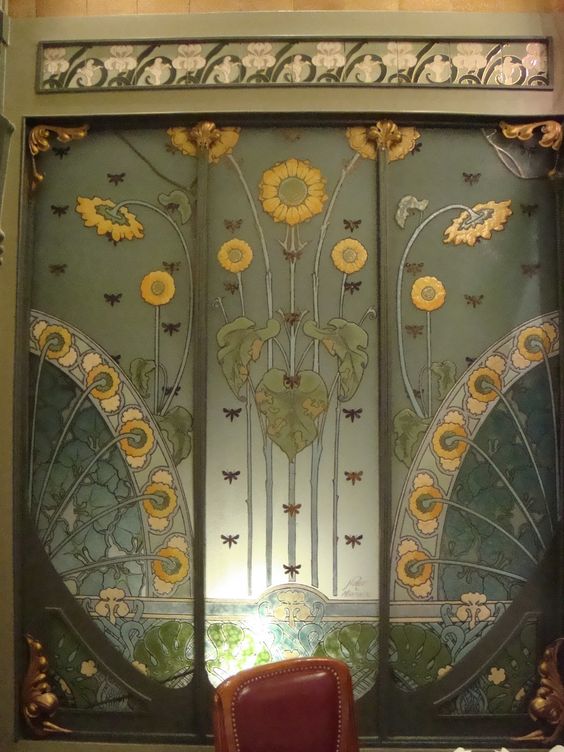
Then, in 1982 an art dealer recognized this room as being virtually identical to a jardin d’hiver (winter garden; a conservatory/greenhouse) dating from 1898 which was up for auction in the Paris suburb of Maisons-Lafitte. The two “Twins” were united with painstaking effort. 5,000 panes of glass and tiles from the Conservatory were meticulously melded with the Marbeuf property to create the Art Nouveau wonder which we see today. In 1983 it was added to the list of historical monuments.
Besides the principal room, the restaurant contains adjacent dining areas. Be certain when making reservations to specify the Salle Verriere, or Salle Belle Époque , as it is also called.
In recent years the restaurant’s culinary excellence has not always measured up to its aesthetic qualities. But in 2016 it was taken over by the Bertrand Group, owners of several other historical eateries such as Brasserie Lipp, Le Procope and Angelina’s. With the change in ownership dining reviews are once again turning more positive. Yet even if there is an occasional misstep in the kitchen, the visual and historical aspects still warrant a visit to Fermette Marbeuf.
La Fermette Marbeuf – 5, rue Marbeuf. 75008, Tel: 01 53 23 08 00
http://www.fermettemarbeuf.com/en/
Julien
In the shadow of Louis XIV’s Triumphal Arch, on the ancient street of Rue de Faubourg Saint Denis, resides one of the city’s sentimental favorites; Brasserie Julien
There has been a tavern or some sort of eatery on this site since before the French Revolution. During the 19th Century it was a refuge of noted painters from the Barbizon School and writers like Alexander Dumas. By the turn of the 20th Century it was in need of a facelift and it’s owner converted it into a bouillon in 1903. Of course, in the euphoric aftermath of the 1900 Universal Exposition, the style could only be Art Nouveau.
The owner’s nephew, Julien Barbarin, inherited the place in the 1920’s and bequeathed his name to it in 1938, calling it Chez Julien. Celebrities of the day like Edith Piaf were regulars at this time. It was converted to a brasserie in 1975 and has enjoyed continued success, still attracting notables like fashion designer Jean-Paul Gaultier and American film star Angelina Jolie.
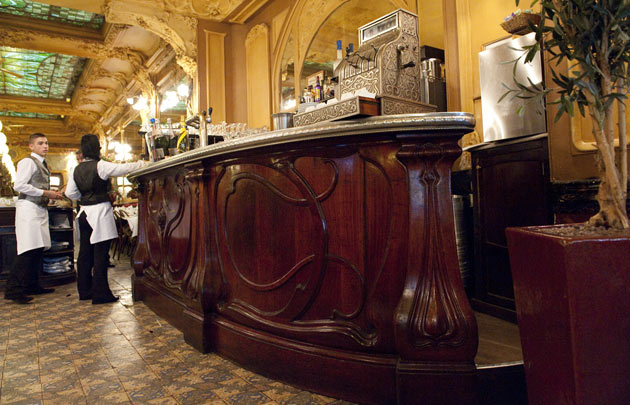
The menu is a mix of traditional brasserie and modern bistro fare. The service is prompt, the prices are moderate and the year is 1903.
Brasserie Julien – 16 Rue du Faubourg Saint-Denis, 75010, Tel: +33 1 47 70 12 06
http://www.julienparis.com/en/
Mollard
From its humble beginnings in 1867, Mollard benefitted greatly from its location directly across from the newly built St. Lazare train station. By 1895 Monsieur Mollard’s success was such that a new and grander remodel was warranted to match the status of this popular brasserie. The task was assigned to famed Belle Époque architect, Édouard-Jean Niermans, designer of the Negresco Hotel in Nice, the Hotel de Paris in Monte Carlo, Angelina’s Tea Room and the Moulin Rouge.
Niermans took personal control of the entire project, including the design of the mosaics, chairs, tables, light fixtures, and even the coat racks. When the project was complete, Mollard was hailed by local newspapers as the most chic and modern restaurant in Paris.
The Nazi occupation of WWII brought deprivation to the citizens of Paris and Mollard provided a free daily soup line to the hardest hit members of its neighborhood throughout the occupation. After the war there was a shortage of office space and Mollard became the defacto “office” for many struggling new businesses. Two days per week the restaurant permitted merchants to use the premises for business, receiving suppliers in the morning and customers in the afternoon. Thus over time Mollard became the rendezvous of some of the city’s top businesses, further insuring its success.
Like many of its fellow Art Nouveau dining halls, Mollard’s fantastic decor was covered over in paint and large mirrors sometime in the first half of the 20th century and not rediscovered until 1965. In 1989 it was added to the register of historical sites
Mollard’s cuisine has its fans and its detractors. Those who know what to expect, and not expect, from a traditional brasserie have no problem. We personally enjoy dropping by in the afternoon (after shopping at the nearby department stores Au Printemps or Gallerie Lafayette), to take a light bite and enjoy a fabulous cup of Mollard’s Hot Chocolate which is on a par with the more renowned chocolat chaud of rival Angelina’s on the rue de Rivoli.
Brasserie Mollard – 115 Rue Saint-Lazare, 75008, Tel: +33 1 43 87 50 22
http://www.mollard.fr/?lang=en
Maxim’s
Ah, Maxim’s . . . Once the most famous restaurant in the world.
Former waiter Maxime Gaillard founded it in 1893 and gave it his name, but it was under it’s next owner, Eugene Cornuché, that it’s fame skyrocketed. Cornuché took over in 1898, decorated the place in over-the-top Art Nouveau style and made it the toast of Belle Époque Paris. Cornuché was a clever marketeer, making sure to have plenty of beautiful young ladies stationed near the windows to attract clientele. These were the days at Maxim’s when aristocrats in black tie and tails would sip champagne from the slippers of diamond-decked and wondrously clad wives and mistresses.
Maxim’s became so famous that the third act of Franz Lehar’s operetta The Merry Widow was set there. In later years it would also appear in numerous plays and films, including the 1958 film Gigi, and most recently, in the 2011 movie Midnight in Paris
In 1932, new owner Octave Vaudable continued to build Maxim’s into a magnet for celebrities. , Jean Cocteau, Marlene Dietrich, Greta Garbo and a host of others were regulars. After world War II Maxim’s was once again the place to see and be seen. The Duke of Windsor and wife, Wallis Simpson, Grace Kelly, Aristotle Onassis and Maria Callas were frequent guests. The star parade continued into the 70’s when Bridgette Bardot created a scandal by arriving barefoot (And was admitted). Other celebs like Barbara Streisand, John Travolta and Kiri Te Kanawa were indicative of the clientele that made Maxim’s the most famous restaurant in the world at this time.
In 1981, The Vaudable family sold Maxim’s to fashion tycoon, Pierre Cardin. Cardin’s organization monetized the brand, almost to the point of ruination. Their Disneyesque marketing of the Maxim’s name has made it better known worldwide but has robbed it of much of its original aura and prestige. Yet the stars keep coming.
Today one can dine (at exorbitant prices) as well as take in its musical cabaret which was added by the Cardin organization. Overall, the culinary experience is a shadow of its former glory but it nonetheless continues to be a magnet to the international jet set and celebrity crowd. If one can block out the celebrity hype for a few brief hours and not be floored by the cost of the experience, the lost world of 1900 Belle Époque Paris might well be temporarily recaptured.
Maxim’s – 3 Rue Royale, 75008, Tel: +33 1 42 65 27 94
Come Dine with us in Paris !
Several of the restaurants described above are on our regular list of dining spots during the weeklong tours we host in the spring and autumn each year. Many other historical eateries are also on the itinerary. We invite you to join us on an upcoming escapade in Paris to experience these and many more great dining places.
In addition to Paris, each year we also host a two week adventure to other parts of Europe. Spring of 2018 will be ITALY, including Florence & Tuscany, the Amalfi Coast and Rome. Spring 2019 will be CENTRAL EUROPE – Prague, Salzburg, Vienna and Budapest.
CLICK HERE for more information on our upcoming trips
CLICK HERE to see REVIEWS from past travelers
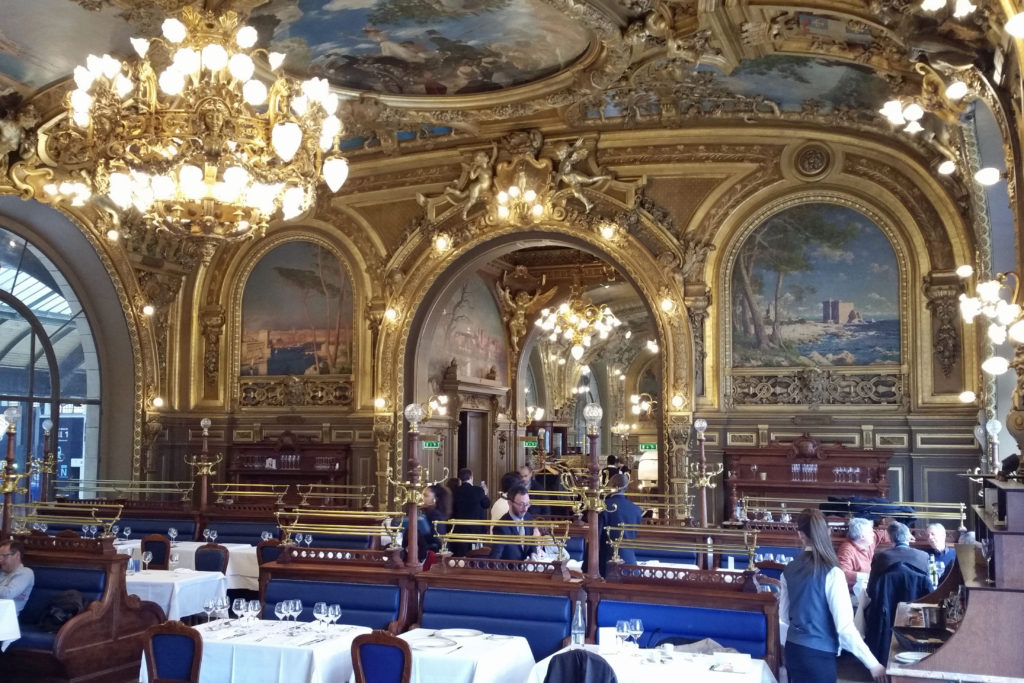
VIDEO Le Train Bleu
2 thoughts on “Dining Amid the “New Art””
Comments are closed.


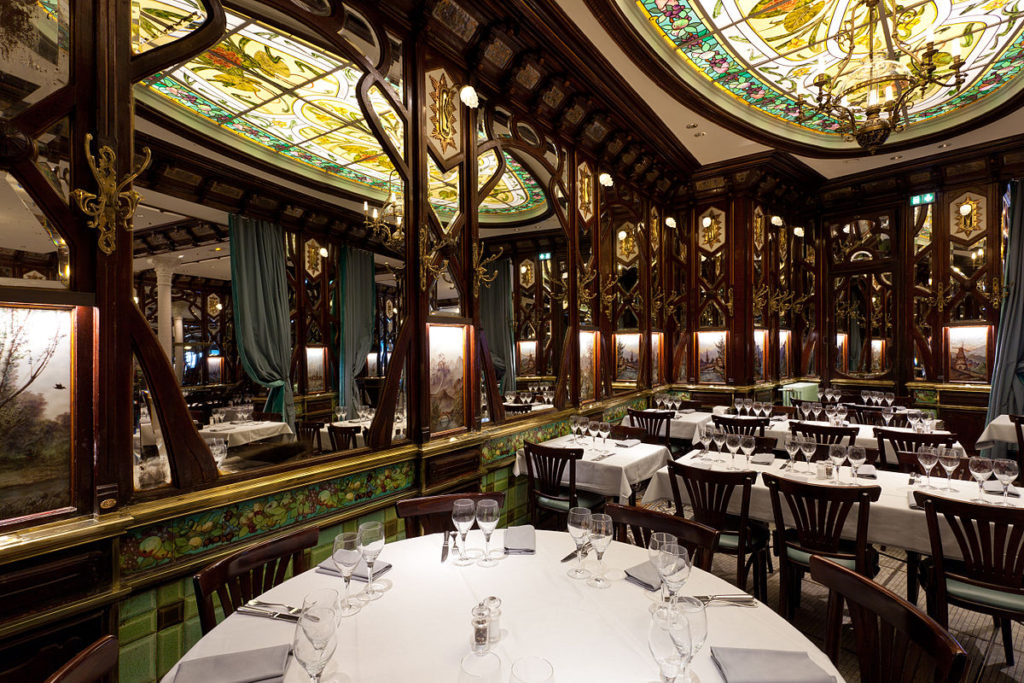
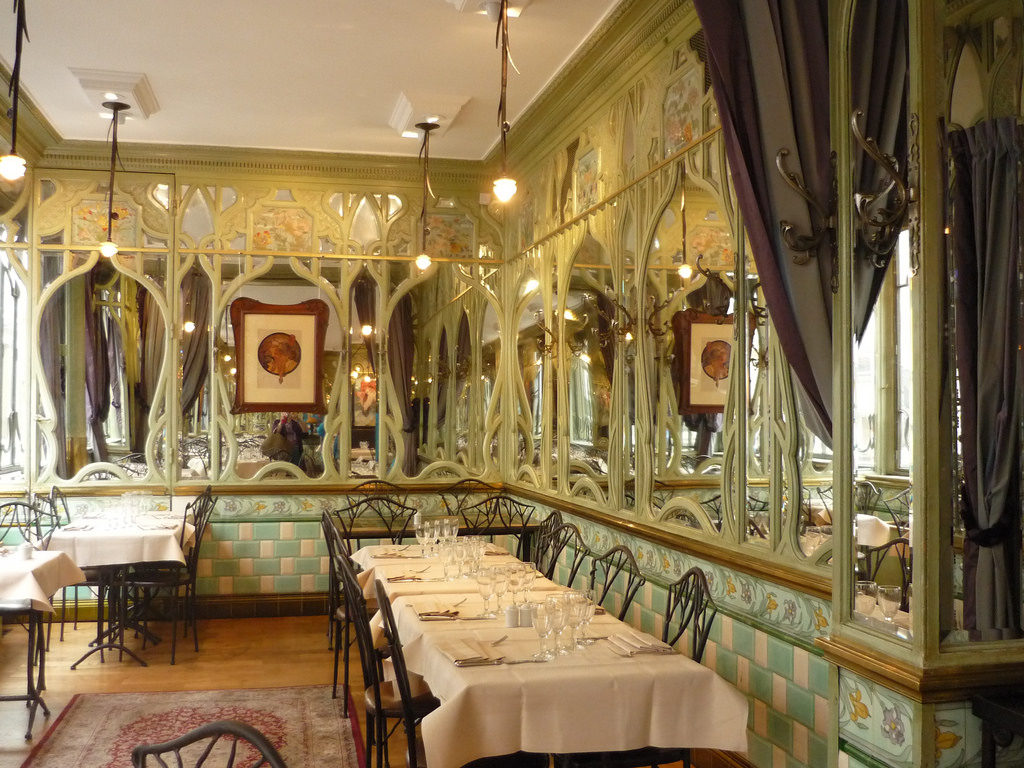
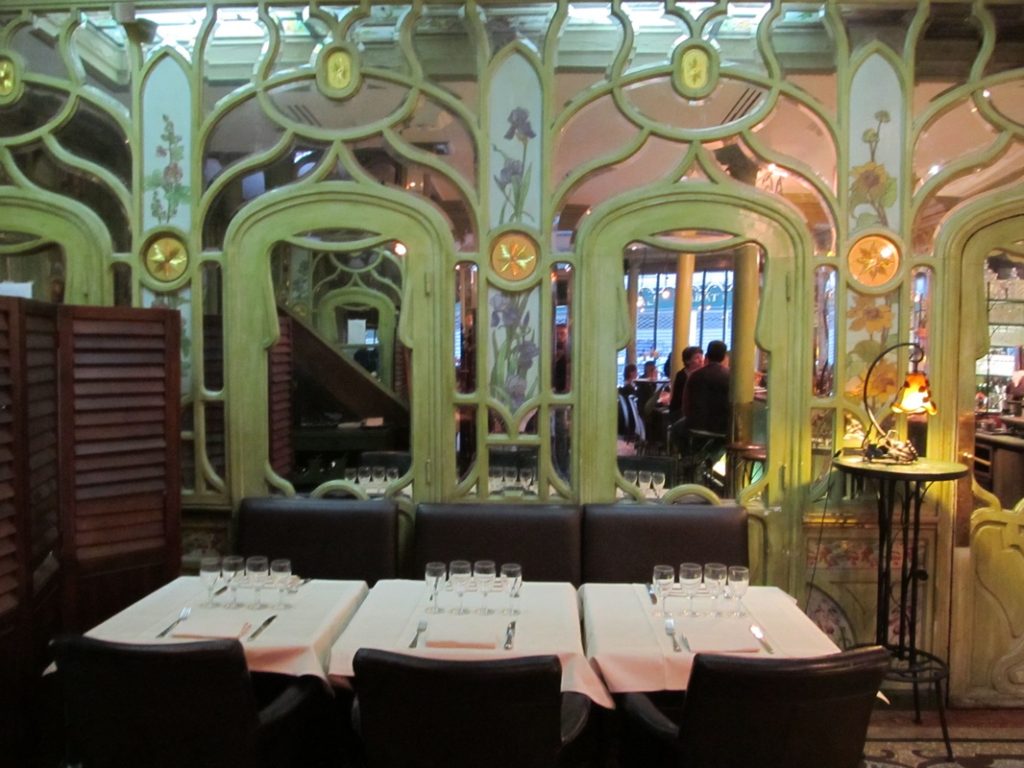
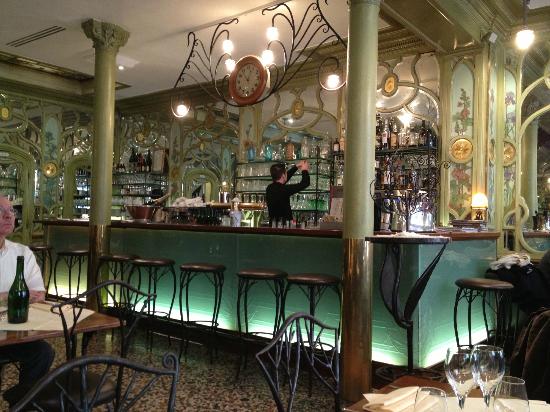
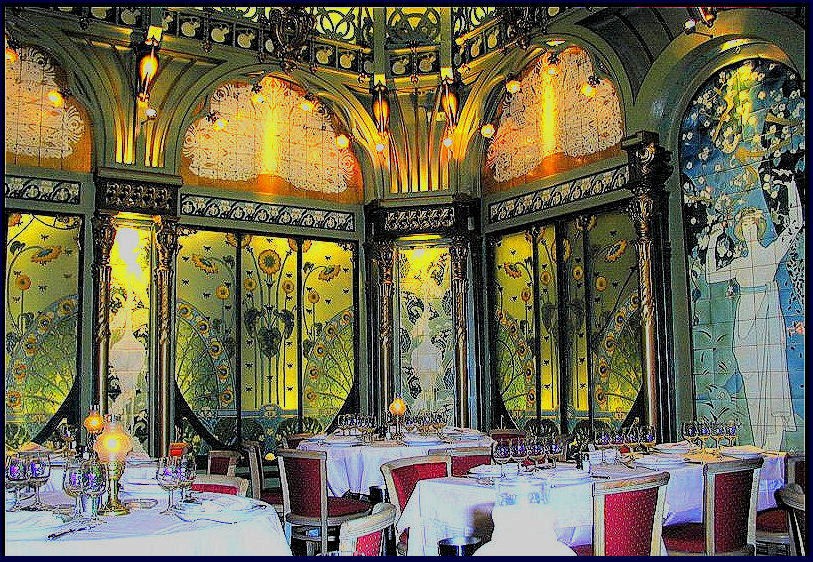
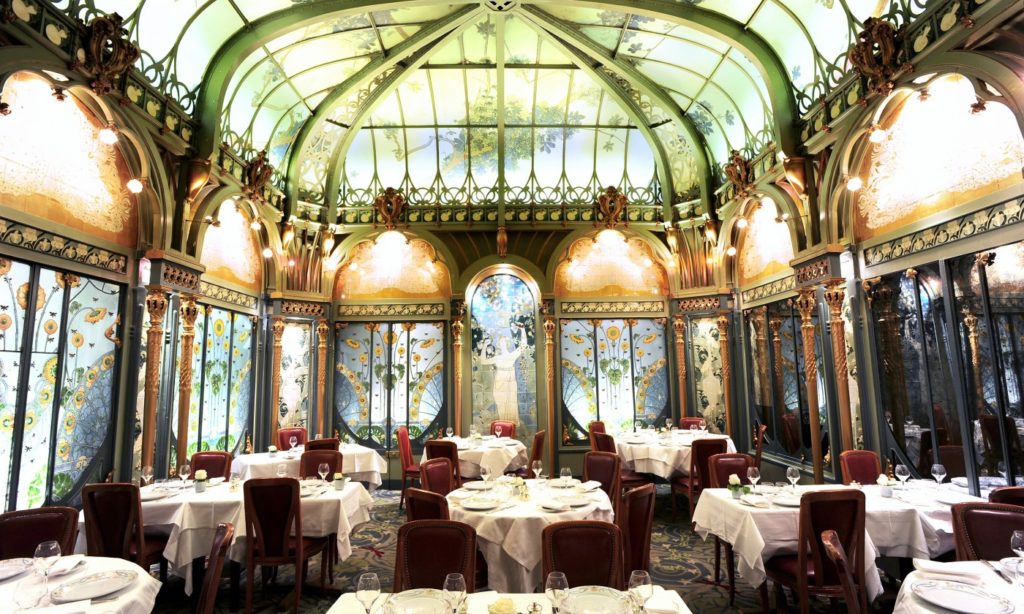
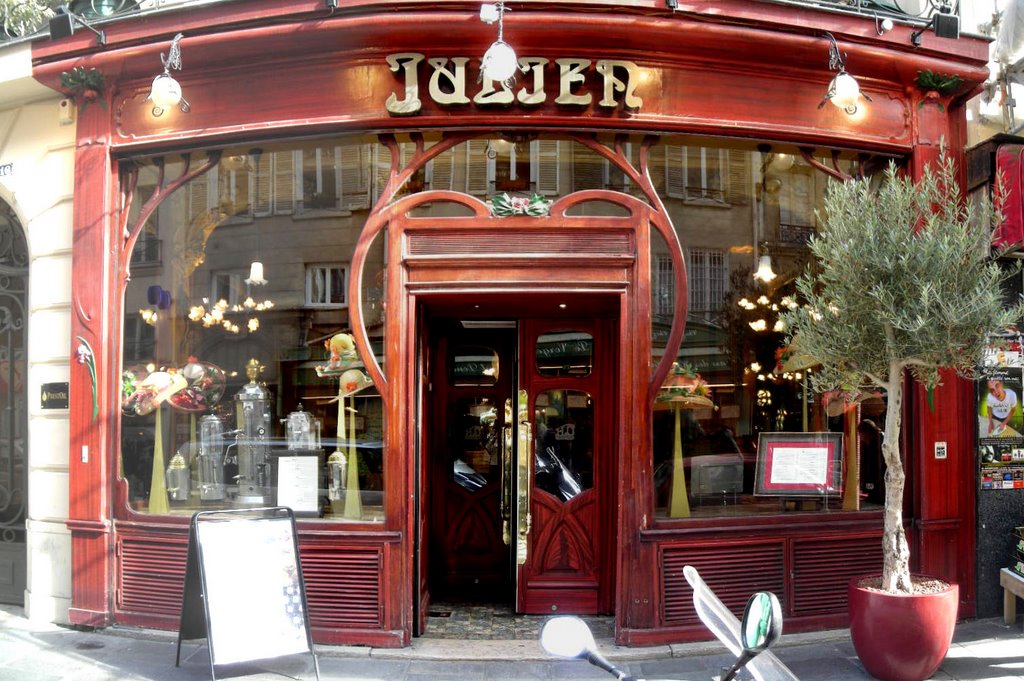
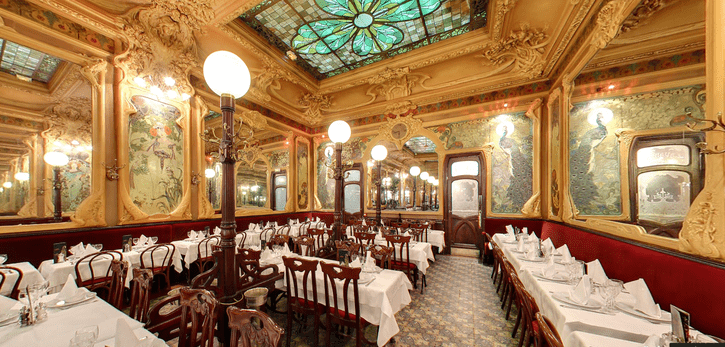
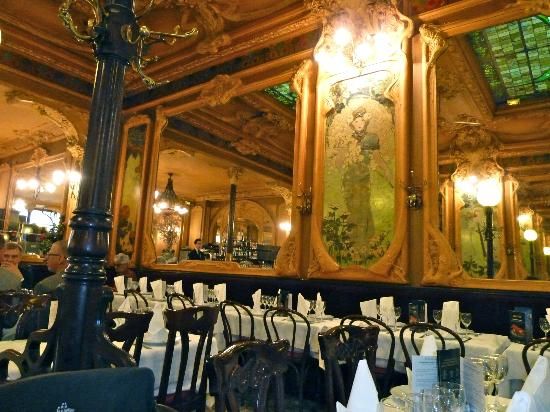

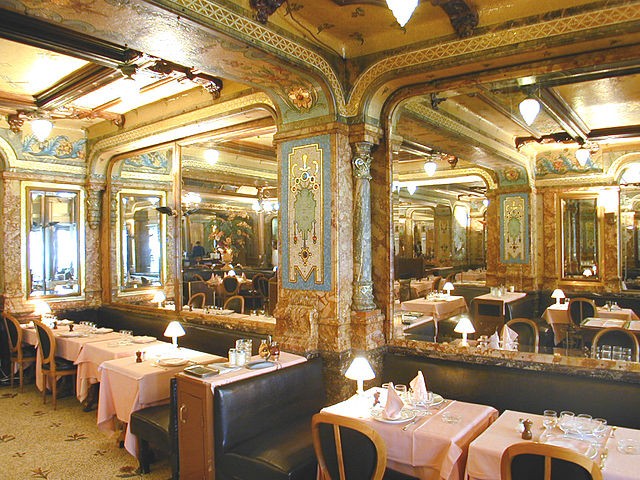
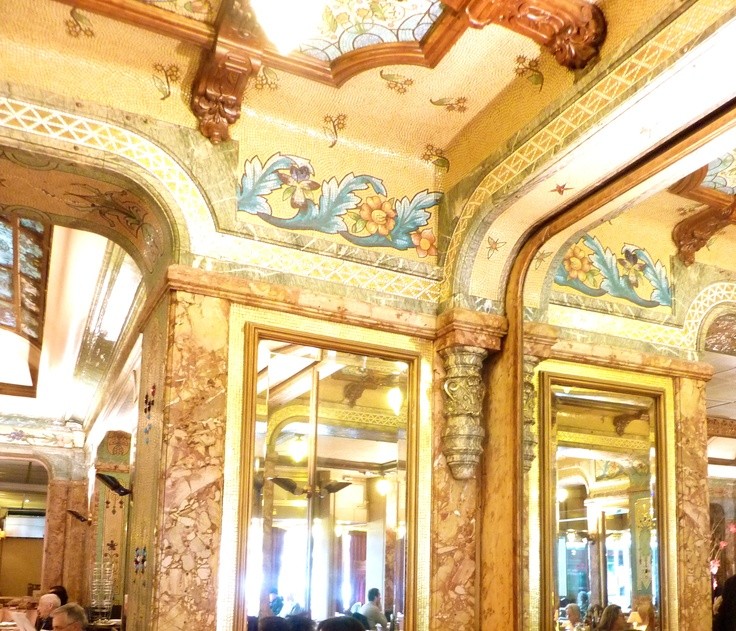

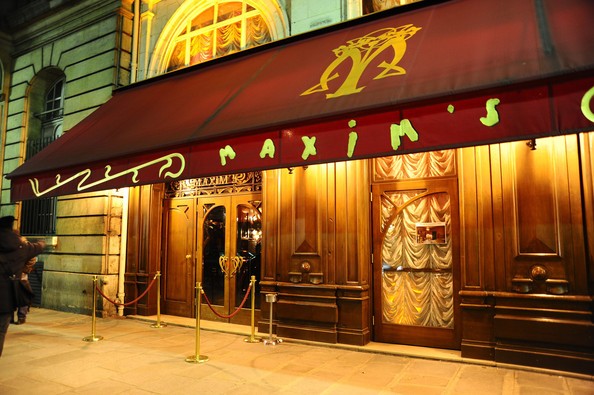
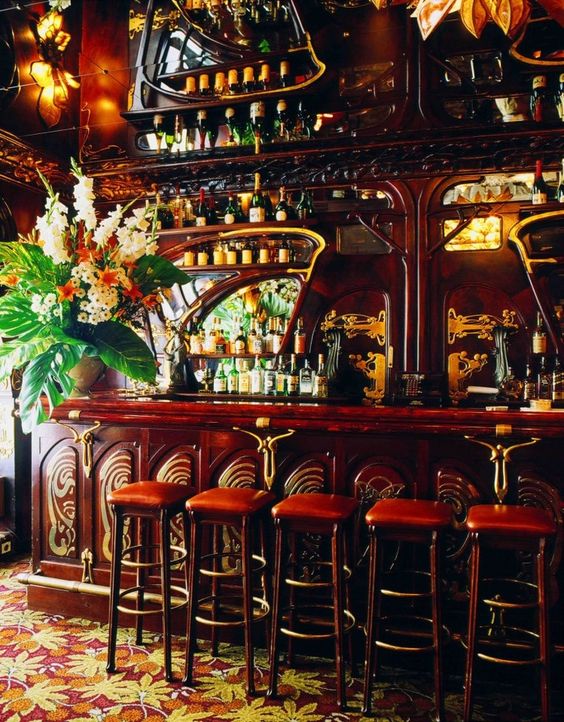
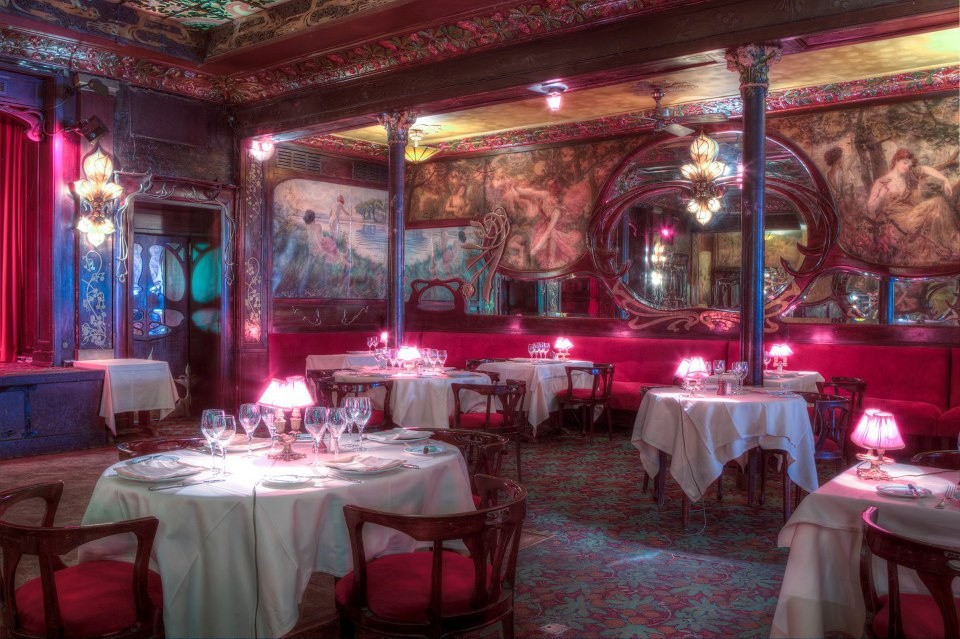
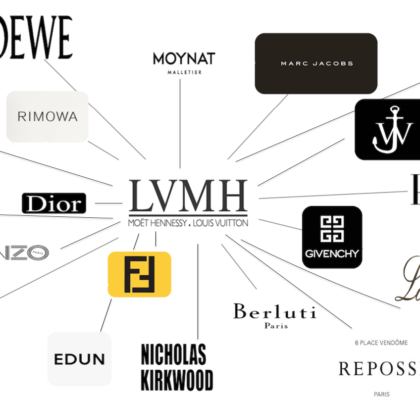
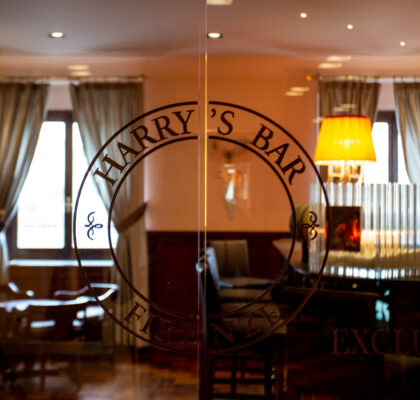
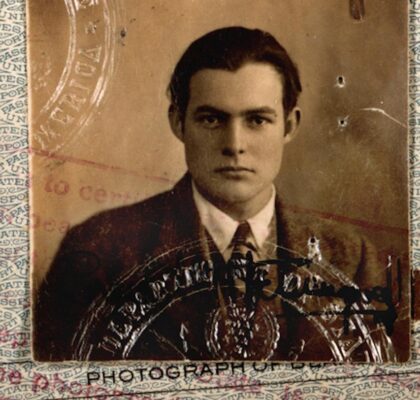
Been to Bouillon Racine at least 3 times. Love their steak tartare! And they make this incredible parsnip soup. Great list of spots!
Hi Lou – Yes, Bouillon Racine has been a favorite of mine since I wandered into it in 1996, right after it reopened following the big facelift. I go as often for a Trappist Ale as for a meal. It has also become a lunchtime favorite when we conclude our walking tour at the nearby Luxembourg Garden.the prix fixe lunch menu is delicious and a great value.